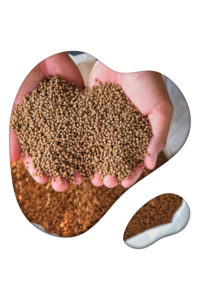Water quality is one of the most critical factors in aquaculture. Poor water conditions can lead to the following, directly affecting farm profitability:
- slow fish growth
- weakened immune systems
- increased mortality
Maintaining optimal water parameters ensures that fish thrive, converting high-quality aquaculture feed—such as fishmeal-based feed—efficiently into body mass. In this blog, we’ll explore the key water quality factors, the role of nutrition in maintaining a clean environment, and best practices for ensuring sustainable fish farming.
Why Water Quality Matters for Fish Health

Water is more than just a habitat—it’s the medium through which fish breathe, excrete waste, and absorb nutrients. Poor water quality can cause stress, making fish more susceptible to diseases and reducing their feed conversion efficiency (FCR).
Some of the most common problems linked to poor water conditions include slow growth, weakened immunity, and low survival rates. When water quality declines, fish are less likely to properly utilize their aquaculture feed, leading to higher feed costs and lower profitability.
Key Water Quality Parameters to Monitor
Maintaining ideal water conditions requires constant monitoring of several key parameters:
- pH Levels – Fish thrive within specific pH ranges. Sudden fluctuations can cause stress and reduce appetite.
- Dissolved Oxygen (DO) – Low oxygen levels can suffocate fish, slowing growth and leading to higher mortality rates.
- Ammonia & Nitrite Levels – Fish waste and uneaten feed contribute to ammonia buildup, which is toxic if not properly managed.
- Temperature & Salinity – Different species have specific temperature and salinity needs for optimal growth.
- Turbidity & Water Clarity – Cloudy or debris-filled water reduces oxygen levels and can harbor harmful bacteria.
The Role of Nutrition in Water Quality
While water filtration and aeration systems are vital, nutrition plays an often-overlooked role in maintaining water quality.
How Fish Feed Impacts Water Conditions
Low-quality aquaculture feed can increase waste, leading to higher ammonia levels and poor water conditions. Feeds that are not easily digestible result in excessive waste output, contributing to bacterial growth and oxygen depletion.
The Importance of High-Quality Fishmeal-Based Feed
Fishmeal is a superior protein source in aquaculture feed, offering high digestibility and optimal nutrient absorption. Benefits include:
- Higher protein efficiency, leading to better feed conversion ratios (FCR).
- Reduced waste, minimizing ammonia buildup in water.
- Enhanced growth rates, allowing fish to reach market size faster.
By using premium fishmeal-based feed, fish farmers can reduce water pollution while optimizing fish health and farm profitability.
Best Feeding Practices for Water Quality
To maintain clean water conditions, implement these feeding strategies:
- Avoid Overfeeding – Overfeeding increases uneaten feed in the water, leading to ammonia spikes and bacterial growth.
- Use Automated Feeders – Precision feeding ensures that fish get just the right amount of food.
- Choose High-Digestibility Feed – High-quality fishmeal-based feed minimizes waste production.
Effective Strategies to Maintain Optimal Water Quality
Beyond nutrition, several measures can help maintain the right water conditions for healthy fish growth.
1. Regular Water Testing & Monitoring
Frequent testing of pH, DO, ammonia, and other parameters ensures early detection of imbalances before they become harmful.
2. Filtration & Waste Management
Proper filtration systems remove solid waste and excess nutrients from water, preventing toxicity buildup. Biofilters help convert harmful ammonia into less toxic nitrates.
3. Aeration & Oxygenation
Using aerators or water circulation systems helps maintain sufficient dissolved oxygen levels, reducing fish stress and supporting healthy growth.
4. Biosecurity Measures
Introducing new fish or equipment without proper quarantine can introduce pathogens into the water. Practicing strict biosecurity minimizes disease risks.
5. Algae & Waste Control
Excess feed and fish waste contribute to algal blooms, depleting oxygen and affecting fish health. Managing feeding practices and using natural algae control measures can help prevent harmful algal growth.
Long-Term Benefits of Water Quality Management
Maintaining high water quality doesn’t just improve fish health—it enhances overall farm efficiency and sustainability.
- Higher Growth Rates & FCR – Healthy water conditions maximize fish metabolism, reducing feed waste and increasing yield.
- Lower Disease Risks – Fish in clean water are less likely to develop bacterial or parasitic infections, reducing reliance on antibiotics.
- Improved Profitability – Efficient feed utilization and lower mortality rates lead to better returns for fish farmers.
- Sustainable Aquaculture Practices – Reduced waste output means lower environmental impact, ensuring long-term viability for fish farms.
Conclusion & Key Takeaways
Ensuring optimal water quality is essential for profitable and sustainable aquaculture. By carefully monitoring key water parameters, implementing proper waste management, and using high-quality fishmeal-based feed, fish farmers can enhance fish health, growth rates, and overall farm efficiency. A proactive approach to water quality management not only reduces costs but also supports long-term success in the aquaculture industry.
Frequently Asked Questions (FAQs)
How does poor water quality affect fish health?
Poor water quality leads to stress, slower growth, higher disease susceptibility, and lower feed conversion efficiency, reducing farm profitability.
What are the most important water quality parameters to monitor?
Key parameters include pH, dissolved oxygen, ammonia, nitrites, temperature, and water clarity, all of which influence fish health and growth.
How does fish feed impact water quality?
Low-quality or excess feed increases waste production, leading to ammonia buildup and poor water conditions. High-quality fishmeal-based feed reduces waste and improves feed conversion efficiency.
What measures can fish farmers take to maintain optimal water quality?
Regular water testing, proper filtration, aeration, biosecurity measures, and controlled feeding practices all help maintain a clean and stable aquatic environment.
Why is fishmeal important in aquaculture feed?
Fishmeal provides essential proteins, amino acids, and nutrients that enhance fish growth, improve feed efficiency, and reduce water pollution by minimizing waste output.
How does good water quality contribute to farm profitability?
Healthy water conditions improve fish growth rates, reduce disease risks, and enhance feed efficiency, leading to higher yields and lower operational costs.
